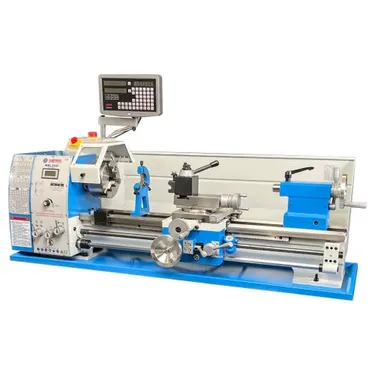What is the Lifespan of a Lathe Machine?
Lathe machines are essential tools in various industries, from woodworking to metalworking. These machines have revolutionized manufacturing by enabling precise shaping and cutting of materials. But, like any piece of equipment, a lathe machine has a limited lifespan. Understanding how long a lathe machine lasts, and what factors influence its longevity, can help you maximize its performance and get the best return on your investment. In this blog post, we’ll explore the typical lifespan of a lathe machine, the factors that affect its durability, and how regular maintenance can extend its life.
The Average Lifespan of a Lathe Machine
A well-maintained lathe machine can last anywhere from 10 to 30 years, depending on several factors. The lifespan can vary based on the type of lathe, its usage, and how well it's cared for. Heavy-duty industrial lathes that are used continuously in high-demand settings may have a shorter lifespan, typically around 10-15 years. On the other hand, lathes used in smaller workshops or for occasional projects can easily last 20-30 years or more.
Factors Affecting the Lifespan of a Lathe Machine
1. Quality of the Lathe Machine
The initial quality of the lathe machine plays a crucial role in its longevity. High-quality machines, made from durable materials and designed with precision, tend to last longer. Investing in a reputable brand and a machine with robust construction can give you peace of mind knowing that your lathe will stand the test of time.
2. Frequency of Use
How often the lathe machine is used directly impacts its lifespan. Machines that are used daily in a production environment are subjected to more wear and tear, which can shorten their operational life. Conversely, lathes that are used infrequently or for light-duty tasks tend to last longer since they experience less stress.
3. Type of Material Machined
The type of material being machined can also affect the lifespan of a lathe. Harder materials, such as steel or cast iron, can cause more wear on the machine's components compared to softer materials like aluminum or wood. Over time, machining hard materials can lead to faster deterioration of the machine’s cutting tools, bearings, and other critical parts.
4. Maintenance Practices
One of the most significant factors influencing the lifespan of a lathe machine is how well it is maintained. Regular maintenance, including lubrication, cleaning, and timely replacement of worn-out parts, can significantly extend the life of a lathe. Neglecting maintenance can lead to premature wear and even costly breakdowns.
Maintenance Tips to Extend the Life of Your Lathe Machine
Proper maintenance is key to ensuring that your lathe machine operates smoothly and lasts as long as possible. Here are some essential maintenance tips to keep your lathe in top shape:
1. Regular Lubrication
Lubrication is crucial for reducing friction between moving parts and preventing wear. Make sure to regularly oil the lathe’s bearings, gears, and lead screws according to the manufacturer’s recommendations. Use the appropriate type of lubricant for each part to ensure optimal performance.
2. Cleaning and Inspection
Dust, metal shavings, and other debris can accumulate on your lathe machine, leading to blockages and wear. Regularly clean the machine, especially after heavy use. Inspect the machine for signs of wear, such as cracks or unusual noises, and address any issues promptly to prevent further damage.
3. Tool Sharpness and Alignment
Dull or misaligned tools can cause excessive wear on the lathe machine and the workpiece. Ensure that all cutting tools are sharp and properly aligned before use. Regularly check the alignment of the lathe’s components, such as the tailstock and headstock, to ensure they are in proper working order.
4. Replacement of Worn Parts
Over time, certain parts of the lathe machine will naturally wear out. These include belts, bearings, and cutting tools. Replacing worn parts before they fail can prevent more significant damage to the machine and avoid costly repairs.
5. Training and Proper Operation
Proper operation of the lathe machine is essential for its longevity. Ensure that all operators are trained in the correct use of the machine and understand the importance of following safety guidelines. Avoid overloading the machine or using it for tasks beyond its designed capacity, as this can lead to premature wear.
Signs That Your Lathe Machine May Need Replacement
Even with the best maintenance practices, a lathe machine will eventually reach the end of its usable life. Here are some signs that it may be time to consider replacing your lathe:
1. Frequent Breakdowns
If your lathe machine is breaking down frequently, it may be more cost-effective to replace it rather than continually repairing it. Frequent repairs can be a sign that the machine’s components are worn out and nearing the end of their lifespan.
2. Decline in Precision
A lathe machine that can no longer produce precise cuts or hold tight tolerances may be worn out. This decline in precision can lead to subpar workpieces and can be a safety hazard if the machine is no longer reliable.
3. Excessive Vibrations
Excessive vibrations during operation can indicate that the machine’s bearings or other components are worn out. Vibrations can lead to inaccurate cuts and can further damage the machine if not addressed.
4. Obsolete Parts
If parts for your lathe machine are becoming difficult to find or are no longer available, it may be time to upgrade to a newer model. Using obsolete parts can lead to inefficiencies and potential safety risks.
Conclusion
The lifespan of a lathe machine depends on various factors, including its initial quality, frequency of use, the type of materials machined, and how well it is maintained. With proper care, a lathe machine can last anywhere from 10 to 30 years, providing reliable service and precise results. Regular maintenance, timely replacement of worn parts, and proper operation are essential for extending the life of your lathe machine and ensuring it performs at its best.



